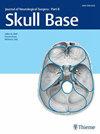Abducens Nerve Duplication:罕见解剖变异的术中和影像学观察新发现
IF 0.9
4区 医学
Q3 Medicine
引用次数: 0
摘要
目的 外展神经在蛛网膜下腔有一条长长的蛇形走向,地形关系复杂,因此外展神经麻痹是成人最常见的眼部运动性颅神经麻痹,在儿童患者中则是第二常见的,文献中也有关于其解剖变异的报道。术前了解外展神经变异解剖有助于防止术中意外损伤。设计 本研究是一份病例报告,回顾了外展神经的解剖结构和变异。研究环境 研究环境包括一家四级转诊中心神经外科的门诊、住院和手术室。参与者 研究对象包括一名 30 岁出头的女性,她被诊断为腰部脑膜瘤。主要结果测量 对 3 型外展神经重复进行了活体记录。结果 建议采用左侧扩大回盲部开颅手术进行蝶鞍部脑膜瘤切除术。术中发现左侧外展神经睫状体段完全重复,并拍摄了照片。术后使用 FIESTA(快速成像稳态采集)序列进行的容积磁共振成像证实了左侧单侧外展神经重复,显示重复的睫状外展神经从 Dorello 管远端合并成一条主干。结论 外展神经变异并不常见,虽然在尸体解剖中也有报道,但活体记录有限。本病例报告了一例活体 3 型外展神经重复,并提供了术中照片和放射影像,强调了临床意识的必要性,以避免术中意外损伤。本文章由计算机程序翻译,如有差异,请以英文原文为准。
Abducens Nerve Duplication: Novel Intraoperative and Radiographic Observation of a Rare Anatomical Variant
Objectives The abducens nerve has a long, serpentine subarachnoid course with complex topographical relationships, rendering abducens nerve palsy the most common ocular motor cranial nerve palsy in adults and second most common in pediatric patients, with anatomical variants reported in the literature. Preoperative awareness of abducens nerve variant anatomy may help prevent inadvertent intraoperative injury. Design This study is a case report with a review of the abducens nerve anatomy and variants. Setting The study setting included outpatient, inpatient, and operating room in the neurosurgery department of a quaternary referral center. Participants The study included a woman in her early 30s with a diagnosis of petrous meningioma. Main Outcome Measures In vivo documentation of a type 3 abducens nerve duplication was carried out. Results A left extended retrosigmoid craniotomy was recommended for the petroclival meningioma resection. Intraoperatively, a complete duplication of the left abducens cisternal segment was encountered and photographed. The left unilateral abducens nerve duplication was confirmed with postoperative volumetric magnetic resonance imaging using the FIESTA (fast imaging employing steady-state acquisition) sequence, revealing the union of the duplicated cisternal abducens nerves into a single trunk from Dorello's canal distally. Conclusions Abducens nerve variants are uncommon, and although reported in the setting of cadaveric dissection, in vivo documentation of them is limited. This case report of an in vivo type 3 abducens nerve duplication with intraoperative photographic and radiographic images highlights the need for clinical awareness to avoid inadvertent intraoperative injury.
求助全文
通过发布文献求助,成功后即可免费获取论文全文。
去求助
来源期刊

Journal of Neurological Surgery Part B: Skull Base
CLINICAL NEUROLOGY-SURGERY
CiteScore
2.20
自引率
0.00%
发文量
516
期刊介绍:
The Journal of Neurological Surgery Part B: Skull Base (JNLS B) is a major publication from the world''s leading publisher in neurosurgery. JNLS B currently serves as the official organ of several national and international neurosurgery and skull base societies.
JNLS B is a peer-reviewed journal publishing original research, review articles, and technical notes covering all aspects of neurological surgery. The focus of JNLS B includes microsurgery as well as the latest minimally invasive techniques, such as stereotactic-guided surgery, endoscopy, and endovascular procedures. JNLS B is devoted to the techniques and procedures of skull base surgery.
 求助内容:
求助内容: 应助结果提醒方式:
应助结果提醒方式:


